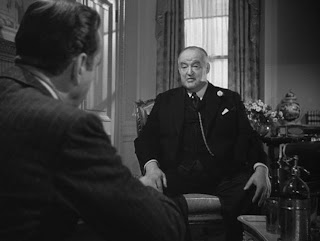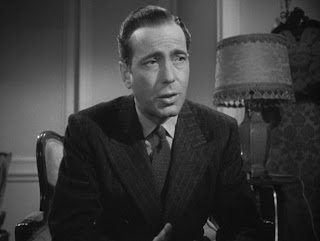
Here again - another post inspired by the Love of Film (Noir) blogathon, which continues apace... This is a pretty direct follow up to my first post - this time, let's look at how John Huston handled the meeting between Gutman and Spade in his version of the Maltese Falcon. Doing this, I admit, isn't quite saying anything about noir - though the comparison of the scenes brings out a couple things that do mark the style...
Both films draw pretty directly on the Hammett book - but there are some notable differences between the way the films handle this scene. First, the Huston version is a good deal longer - and split into two interviews, as in the book. Second - Wilmer's present (in both parts), significantly. And Cairo is not. Those changes illustrate a couple things different in Huston's version - the supporting characters have quite a bit more to do in the 1941 version. Gutman and Cairo are featured in the first, but Wilmer is almost a cameo. (A shame since it's Dwight Frye, who brings even more baby faced psychopathy to the role than Elisha Cook.) The other change - removing Cairo from the scene - is directly relevant to the evolution of film noir, I think. Huston's version never departs from Spade's point of view. That's a fairly important element in noir - the limitation of knowledge. Characters who are in the dark - and audiences who are kept in the dark with them. We don't get the outside perspective, we don't know more than the characters. We share their subjectivity.
As for this scene - in some ways, it is actually more conventional than in Del Ruth's version. Instead of beginning in the middle of the conversation, as Del Ruth did, we start with an establishing three shot -

- then move closer through a series of alternations. The effect is less jarring than in the 1931 film - also, better integrated into the film as a whole. This scene comes as a departure from the otherwise stolid style of the 1931 film - here, the angles, decor, and so on are used as in the rest of the film.





Huston's framings aren't quite as jarring as Del Ruth's, but in this film too, the objects, decor, and so on, are very prominent. Bottles, lamps, paintings, light and dark, windows and so on surround the characters - sometimes innocuously, sometimes as pure visual elements - but always seeming to be waiting to take on significance....


The sequence builds to this very famous low angle shot of Gutman - then Spade jumps up, and we get this - not quite as low, but noticeable - and Sam's threatening gesture echoing the painting behind him....

... Wilmer comes back in, and we get this lovely, tense triangle (lots of triangles in this film), before Spade storms off...

When Spade returns, Huston follows much the same pattern. Establishing shots with Spade, Gutman and WIlmer, then a two shot, Spade on the couch now...

He alternates closer shots, shooting Gutman from below...

...and Spade more from eye level (though below Gutman's POV) - with Spade starting to look hemmed in by the bottles and flowers and background decor...

...Gutman rises to pour the spiked drink, looming over Spade -

- and shot from below, as he looks down on Spade, waiting for the mickey to kick in -

- and as it does, the camera comes closer, catching his anticipation -

...then moving closer to Spade, surrounded by bottles and flowers and curtains, looking up, starting to drift a bit...

And ending, with a pair of shots of the men on the couch, the fatal glasses raised...

And so... you can see the evolution of filmmaking in the ten years between these films - in Huston's moving camera, the more expansive staging, and so on... But also the continuity - the similar use of decor, of props, the similar framings - low(ish) angles, the prominent placement of props in the shots. And the specific differences, as in the very different conceptions of Gutman... As it happens - this is clearly the high point of the 1931 film - and probably the high point in 1941 as well. The dialogue shines - the performances shine - and both filmmakers rise to the moment. A conversation between two men - but one frought with deception, threat, menace - which you get from the way the scenes look. And those bottles, glasses, resting there like loaded guns... neat stuff.

No comments:
Post a Comment